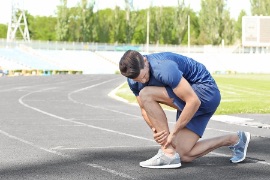 Shin splints, known medically as medial tibial stress syndrome develop due to repeated stress on bones, muscles, and tendons in the lower legs that hinder the body’s ability to heal properly. A shin splint typically causes pain on the inner side of the lower leg where the tibia or shin bone connects to muscles that provide support. However, the pain is the result of inflammation that has accumulated over time. This type of injury is common in athletes such as runners, basketball players, and dancers.
Shin splints, known medically as medial tibial stress syndrome develop due to repeated stress on bones, muscles, and tendons in the lower legs that hinder the body’s ability to heal properly. A shin splint typically causes pain on the inner side of the lower leg where the tibia or shin bone connects to muscles that provide support. However, the pain is the result of inflammation that has accumulated over time. This type of injury is common in athletes such as runners, basketball players, and dancers.
In addition to athletes, individuals who engage in repetitive activities, such as stepping on and off a ladder, or those who place excessive force on the muscles in the lower legs (e.g. jumping on a hard surface) are more susceptible to shin splints. Some people also develop shin splints due to stress fractures in the shin bone. The body can repair these types of microscopic cracks on its own when the legs are given a chance to rest, but if the activity associated with the injury continues, a minor stress fracture will worsen.
How to Treat a Shin Splint
One of the most beneficial ways to encourage natural healing if you experience a shin splint is to rest your leg temporarily. This means avoiding the activity (e.g., sport, job task) that caused the injury for about 1-2 weeks, if possible.
Additional management approaches include:
- Using over-the-counter nonsteroidal anti-inflammatory drugs (NSAIDs) such as ibuprofen or aspirin to reduce inflammation and pain.
- Placing an ice pack on the affected region for about 20 minutes at different times throughout the day.
- Wrapping the injured leg with a compression bandage to help minimize swelling.
- Gently stretching your lower leg muscles to promote flexibility and decrease stiffness. Stretches for the gastrocnemius, soleus and tibialis anterior are the main muscles that need to be addressed.
- Wearing shoes with proper support (e.g., fitness shoes, sneakers) to reduce excessive force on the lower legs. Replace shoes when they show signs of wear.
- Placing orthotics—shock-absorbing insoles—inside your shoes to help stabilize the foot and take stress off the shin during forceful movements. Feet with excessive or prolonged pronation (flat foot) cause excessive stress on the posterior tibialis tendon and would benefit from orthotics or running shoes to correct such a deviation.
- Carefully returning to previous activities by starting out slowly and then gradually increasing the duration and intensity.
You should also consider working with a physical therapist who can help pinpoint the cause of the shin splint in order to demonstrate effective therapeutic techniques that promote healing and help prevent future injuries.
Strategies to Prevent Shin Splints
To prevent shin splints or reduce the risk of recurring shin injuries, consider using the following strategies:
- Wear shoes that offer proper heel and arch support: It is important to choose fitness shoes carefully. For example, spiked sneakers may increase your risk of developing shin splints. Athletic sneakers usually minimize the flexing of the foot and decrease pressure that is placed on joints during vigorous activity.
- Warm-up before intense physical activity: A dynamic warm-up, as opposed to a static warm-up, fully engages the entire body in preparation for more strenuous movements. Dynamic stretching typically mimics actions that will be performed for a particular sport, exercise routine, or job task. For example, forward or side-to-side lunges help strengthen and tone shin muscles. Research even shows that performing a dynamic warm-up regularly improves flexibility and enhances performance.
- Maintain a good weight. Excessive weight may contribute to tissue overload and strain.
If you need additional assistance, our physical therapists at Iron City Physical Therapy would be happy to speak with you about our state-of-the-art pain management services and design a program that is tailored to your specific needs. Call today to schedule a consultation.
References
- Thacker SB, Gilchrist J, Stroup DF, Kimsey CD. The prevention of shin splints in sports: a systematic review of literature. Med Sci Sports Exerc. 2002; 34(1):32-40.
- Newman P, Witchalls J, Waddington G, Adams R. Risk factors associated with medial tibial stress syndrome in runners: a systematic review and meta-analysis. Open Access J Sports Med. 2013; 4:229-241.
- Rome K, Handoll HH, Ashford R. Interventions for preventing and treating stress fractures and stress reactions of bone of the lower limbs in young adults. Cochrane Database Syst Rev. 2005; (2):CD000450.
- Greensword M, Aghazadeh F, Al-Qaisi S. Modified track shoes and their effect on the EMG activity of calf muscles. Work. 2012; 41 Suppl 1:1763-1770.
- Perrier ET, Pavol MJ, Hoffman MA. The acute effects of a warm-up including static or dynamic stretching on countermovement jump height, reaction time, and flexibility. J Strength Cond Res. 2011; 25(7):1925-1931.




